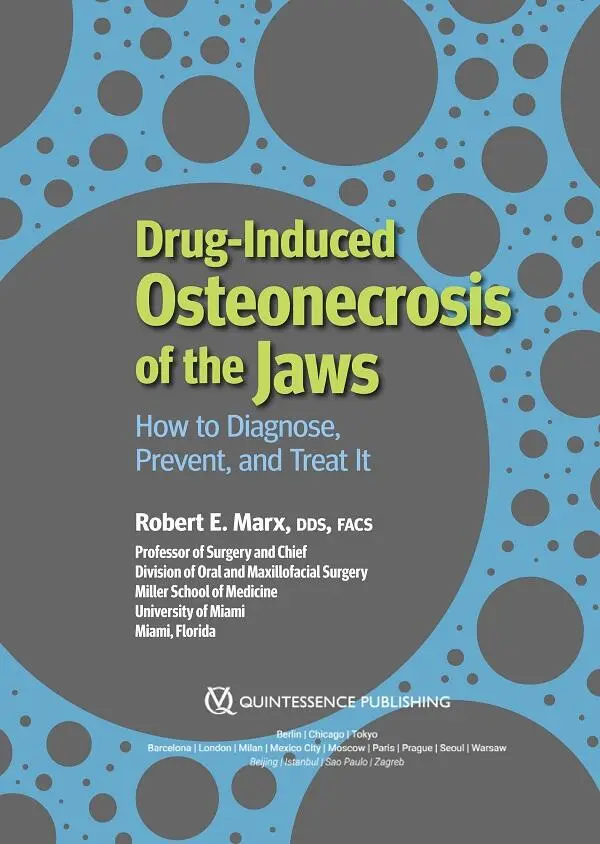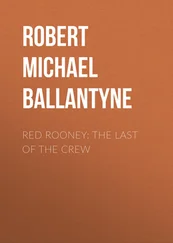Drug-Induced Osteonecrosis of the Jaws
How to Diagnose, Prevent, and Treat It

Library of Congress Cataloging-in-Publication Data
Names: Marx, Robert E., author.
Title: Drug-induced osteonecrosis of the jaws : how to diagnose, prevent, and treat it / Robert E. Marx.
Description: Batavia, IL : Quintessence Publishing Co, Inc, [2021] | Includes bibliographical references and index. | Summary: “Explores the science behind DIONJ before presenting the protocols for treating the disease in patients with osteoporosis and/or cancer. Special attention is paid to how to prevent DIONJ from developing in vulnerable sites and populations”-- Provided by publisher.
Identifiers: LCCN 2021029327 | ISBN 9781647240899 (paperback)
Subjects: MESH: Bisphosphonate-Associated Osteonecrosis of the Jaw | Diphosphonates--adverse effects | Bone Density Conservation Agents--adverse effects | Antineoplastic Agents--adverse effects
Classification: LCC RC931.O73 | NLM WU 140.5 | DDC 616.7/1606--dc23
LC record available at https://lccn.loc.gov/2021029327
A CIP record for this book is available from the British Library.
ISBN: 9781647240899

©2022 Quintessence Publishing Co, Inc
Quintessence Publishing Co, Inc
411 N Raddant Road
Batavia, IL 60510
www.quintpub.com
5 4 3 2 1
All rights reserved. This book or any part thereof may not be reproduced, stored in a retrieval system, or transmitted in any form or by any means, electronic, mechanical, photocopying, or otherwise, without prior written permission of the publisher.
Editor: Leah Huffman
Design: Sue Zubek
Production: Angelina Schmelter
Printed in Croatia
Dedication Dedication Indeed, a dog can be man’s best friend. I have been blessed to have grown up with and lived my adult life with such dogs. Due to their shorter life span than ours, their love and loyalty too often fade with the years. To commemorate that love and loyalty as well as every lick in the face, I want to dedicate this book to them in the order that they were with me: Blackie, Teeka, Cinder, Cindy, Lillie, Lucky, Rusty, Odie, Bones, Ninja, Rocky, Tubby, and Libby and Copper, who are still with me and my wife.
Preface Preface Dead bone in the mouth, known as drug-induced osteonecrosis of the jaws (DIONJ) , is a problem that every dental and oral and maxillofacial surgeon faces. It is also a problem that every oncologist faces. What was first recognized in 2003 and linked to bisphosphonates has been expanded to include RANK ligand inhibitors and antiangiogenic drugs. The numbers of DIONJ cases have accumulated into tens of thousands and have caused bone loss, infection, pain, and deformity in many individuals. DIONJ is a drug complication that has not gone away, nor is it likely to go away. Most of the responsibility in preventing and managing the complication of this medical drug therapy falls on the dental profession and its specialties. This author has published two previous texts on DIONJ (2007 and 2011) identifying the biologic mechanism of bone necrosis, its pathophysiology, and suggestions on its management. This new text accepts and does not dwell on the known pathophysiology of DIONJ from each drug. Instead, it concentrates its attention on specific measures the clinician can practice to prevent DIONJ, to assess risk, to slow its progress, to prevent worsening it, and to resolve it when it does occur. This text, with its case samples, outlines specific medical history questions to ask patients as well as specific caveats of the oral examination related to DIONJ identification and assessment. It also presents specific antibiotic protocols that have proven best in controlling secondary infection. A new and more useable staging system is introduced that will help the clinician in disease assessment and treatment planning. For the osteoporosis/osteopenia patient, the effective use of drug holidays allows the dental and oral and maxillofacial surgeon to perform indicated procedures with greater safety. The newly discovered role of occlusion and occlusal trauma in initiating DIONJ has led to the before-unrecognized preventive value of occlusal adjustments, the splinting of teeth, and mouthguards. It is hoped that this book will serve as a guide for each provider to lessen the impact of DIONJ on their patients while still maintaining the dental and reconstruction/rehabilitation services we are known to provide.
1 Understanding Drug-Induced Osteonecrosis of the Jaws
2 Prevention and Management of DIONJ in Patients Treated for Osteopenia/Osteoporosis
3 Prevention and Management of DIONJ in Cancer Patients Taking Drugs Known to Cause DIONJ
Index
Indeed, a dog can be man’s best friend. I have been blessed to have grown up with and lived my adult life with such dogs. Due to their shorter life span than ours, their love and loyalty too often fade with the years. To commemorate that love and loyalty as well as every lick in the face, I want to dedicate this book to them in the order that they were with me: Blackie, Teeka, Cinder, Cindy, Lillie, Lucky, Rusty, Odie, Bones, Ninja, Rocky, Tubby, and Libby and Copper, who are still with me and my wife.
Dead bone in the mouth, known as drug-induced osteonecrosis of the jaws (DIONJ) , is a problem that every dental and oral and maxillofacial surgeon faces. It is also a problem that every oncologist faces.
What was first recognized in 2003 and linked to bisphosphonates has been expanded to include RANK ligand inhibitors and antiangiogenic drugs. The numbers of DIONJ cases have accumulated into tens of thousands and have caused bone loss, infection, pain, and deformity in many individuals. DIONJ is a drug complication that has not gone away, nor is it likely to go away. Most of the responsibility in preventing and managing the complication of this medical drug therapy falls on the dental profession and its specialties.
This author has published two previous texts on DIONJ (2007 and 2011) identifying the biologic mechanism of bone necrosis, its pathophysiology, and suggestions on its management. This new text accepts and does not dwell on the known pathophysiology of DIONJ from each drug. Instead, it concentrates its attention on specific measures the clinician can practice to prevent DIONJ, to assess risk, to slow its progress, to prevent worsening it, and to resolve it when it does occur.
This text, with its case samples, outlines specific medical history questions to ask patients as well as specific caveats of the oral examination related to DIONJ identification and assessment. It also presents specific antibiotic protocols that have proven best in controlling secondary infection. A new and more useable staging system is introduced that will help the clinician in disease assessment and treatment planning.
For the osteoporosis/osteopenia patient, the effective use of drug holidays allows the dental and oral and maxillofacial surgeon to perform indicated procedures with greater safety. The newly discovered role of occlusion and occlusal trauma in initiating DIONJ has led to the before-unrecognized preventive value of occlusal adjustments, the splinting of teeth, and mouthguards.
Читать дальше














